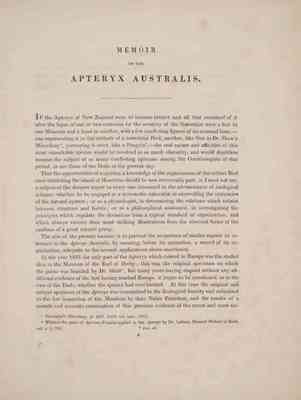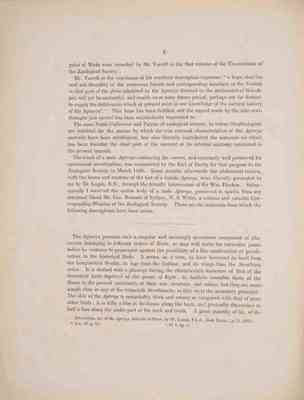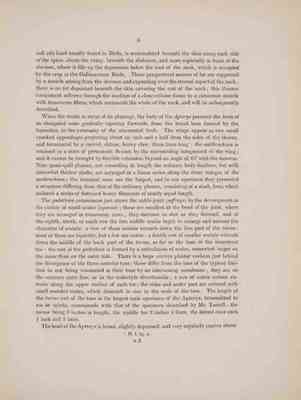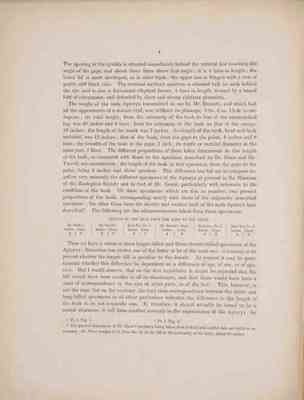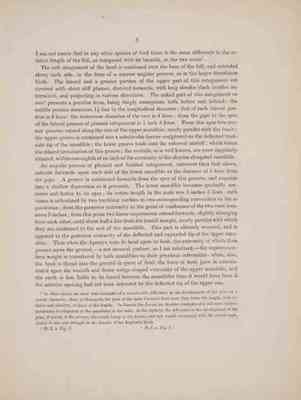Pages
21
MEMOIR ON THE APTERYX AUSTRALIS.
If the Apteryx of New Zealand were to become extinct and all that remained of it after the lapse of one or two centuries for the scrutiny of the Naturalist were a foot in one Museum and a head in another, with a few conflicting figures of its external form, -- one representing it in the attitude of a terrestrial Bird, another, like that in Dr. Shaw's Miscellany1, portraying it erect, like a Penguin2, -- the real nature and affinities of this most remarkable species would be involved in as much obscurity, and would doubtless become the subject of as many conflicting opinions among the Ornithologists of that period, as are those of the Dodo at the present day.
That the opportunities of acquiring a knowledge of the organization of the extinct Bird once inhabiting the island of Mauritius should be now irrevocably past, is, I need not say, a subject of the deepest regret to every one interested in the advancement of zoological science : whether he be engaged as a systematic naturalist in unravelling the intricacies of the natural system ; or as a physiologist, in determining the relations which subsist between structure and habits ; or as a philosophical anatomist, in investigating the principles which regulate the deviations from a typical standard of organization, and which always receive their most striking illustrations from the aberrant forms at the confines of a great natural group.
The aim of the present memoir is to prevent the recurrence of similar regrets in reference to the Apteryx Australis, by securing, before its extinction, a record of its organization, adequate to the several applications above- mentioned.
In the year 1833 the only part of the Apteryx which existed in Europe was the stuffed skin in the Museum of the Earl of Derby; this was the original specimen on which the genus was founded by Dr. Shaw3; but many years having elapsed without any additional evidence of the bird having reached Europe, it began to be questioned, as in the case of the Dodo, whether the species had ever existed. At this time the original and unique specimen of the Apteryx was transmitted to the Zoological Society and submitted to the free inspection of the Members by their Noble President, and the results of a minute and accurate examination of this precious evidence of the rarest and most sin-
1. Naturalist's Miscellany, pl.1057,1058. vol. xxiv. 1813. 2 Whence the name of Apteryx Penguin applied to the Apteryx by Dr. Latham, General History of Birds. vol. x. p. 394. 3Loc. cit. B
22
2 gular of Birds were recorded by Mr. Yarrell in the first volume of the Transactions of the Zoological Society1.
Mr. Yarrell at the conclusion of his excellent description expresses "a hope, that the zeal and liberality of the numerous friends and corresponding members of the Society in that part of the globe inhabited by the Apteryx directed to the attainment of this object will yet be successful, and enable us at some future period, perhaps not far distant, to supply the deficiencies which at present exist in our knowledge of the natural history of the Apteryx2." This hope has been fulfilled, and the appeal made by the able ornithologist just quoted has been satisfactorily responded to.
The same Noble Cultivator and Patron of zoological science, to whom Ornithologists are indebted for the means by which the true external characteristics of the Apteryx australis have been established, has also liberally contributed the materials on which has been founded the chief part of the account of its internal anatomy contained in the present memoir.
The trunk of a male Apteryx containing the viscera, and extremely well preserved for anatomical investigation, was transmitted by the Earl of Derby for that purpose to the Zoological Society in March 1838. Some months afterwards the abdominal viscera, with the bones and tendons of the feet of a female Apteryx, were liberally presented to me by Dr. Logan, R.N., through the friendly intercession of Sir Wm. Hooker. Subsequently I received the entire body of a male Apteryx, preserved in spirits, from my esteemed friend Mr. Geo. Bennett of Sydney, N. S. Wales, a zealous and valuable Corresponding Member of the Zoological Society. These are the materials from which the following descriptions have been taken.
The Apteryx presents such a singular and seemingly anomalous compound of characters belonging to different orders of Birds, as may well make the naturalist pause before he ventures to pronounce against the possiblity of a like combination of peculiarities in the historical Dodo. It seems, as it were, to have borrowed its head from the Longirostral Grallae, its legs from the Gallinae, and its wings from the Struthious order. It is clothed with a plumage having the characteristic looseness of that of the terrestrial birds deprived of the power of flight ; its feathers resemble those of the Emeu in the general uniformity of their size, structure and colour, but they are more simple than in any of the tridactyle Struthionidae, as they want the accessory plumelet'. The skin of the Apteryx is remarkably thick and strong as compared with that of most other birds ; it is fully a line in thickness along the back, and gradually diminishes to half a line along the under part of the neck and trunk. A grest quantity of fat, of the
1Description, &c. of the Apteryx Australis of Shaw, by W. Yarrell, F. L. S. ,Zool. Trans. i. p. 71. 1883 2Loc. cit. p .75. 3 Pl. I. fig. 5.
23
3
soft oily kind usually found in Birds, is accumulated beneath the skin along each side of the spine, about the rump, beneath the abdomen, and more especially in front of the sternum, where it fills up the depression below the root of the neck, which is occupied by the crop in the Gallinaceous Birds. These praepectoral masses of fat are supported by a muscle arising from the sternum and expanding over the sternal aspect of the neck : there is no fat deposited beneath the skin covering the rest of the neck ; this thinner integument adheres through the medium of a close cellular tissue to a cutaneous muscle with transverse fibres, which surrounds the whole of the neck, and will be subsequently described.
When the trunk is stript of its plumage, the body of the Apteryx presents the form of an elongated cone gradually tapering forwards, from the broad base formed by the haunches, to the extremity of the attenuated beak. The wings appear as two small crooked appendages projecting about an inch and a half from the sides of the thorax, and terminated by a curved, obtuse, horny claw, three lines long1 : the antibrachium is retained in a state of permanent flexion by the surrounding integument of the wing ; and it cannot be brought by forcible extension beyond an angle of 45[degree symbol] with the humerous. Nine quasi-quill-plumes, not exceeding in length the ordinary body-feathers, but with somewhat thicker shafts, are arranged in a linear series along the ulnar margin of the antibrachium ; the terminal ones are the largest, and in one specimen they presented a structure differing from that of the ordinary plumes, consisting of a shaft, from which radiated a series of flattened horny filaments of nearly equal length.
The podotheca commences just above the ankle-joint (suffrago) by the development in the cuticle of small scales (squamae) ; these are smallest at the bend of the joint, where they are arranged in transverse rows ; they increase in size as they descend, and at the eighth, ninth, or tenth row the two middle scales begin to enlarge and assume the character of scutulae : a row of these scutulae extends down the fore part of the tarsus ; most of them are bipartite, but a few are entire : a double row of smaller scutulae extends down the middle of the back part of the tarsus, as far as the base of the innermost toe : the rest of the podotheca is formed by the reticulation of scales, somewhat larger on the inner than on the outer side. There is a large convex plantar cushion just behind the divergence of the three anterior toes : these differ from the toes of the typical Gallinae in not being connected at their base by an intervening membrane ; they are on the contrary quite free, as in the tridactyle Struthionidae ; a row of entire scutulae extends along the upper surface of each toe ; the sides and under part are covered with small rounded scales, which diminish in size to the ends of the toes. The length of the tarsus and of the toes in the largest male specimen of the Apteryx, transmitted to me in spirits, corresponds with that of the specimen described by Mr. Yarrell ; the tarsus being 3 inches in length, the middle toe 2 inches 4 lines, the lateral ones each 1 inch and 5 lines.
The head of the Apteryx is broad, slightly depressed and very regularly convex above.
1 Pl. I fig. 4. B2
24
4
The opening of the eyelids is situated immediately behind the vertical line touching the angle of the gape, and about three lines above that angle ; it is 4 lines in length : the lower lid is most developed, as in other birds ; the upper one is fringed with a row of pretty stiff black cilia. The external auditory aperture is situated half an inch behind the eye, and is also a horizontal elliptical fissure, 4 lines in length, formed by a tumid fold of integument, and defended by short and strong ciliiform plumelets.
The weight of the male Apteryx transmitted to me by Mr. Bennett, and which had all the appearances of a mature bird, was, without its plumage, 3lbs. 6 oz. 12 dr. avoirdupoise ; its total length, from the extremity of the beak to that of the outstretched leg, was 28 inches and 8 lines ; from the extremity of the beak to that of the coccyx, 19 inches ; the length of the trunk was 7 inches ; the length of the neck, head and beak included, was 12 inches ; that of the beak, from the gape to the point, 4 inches and 8 lines ; the breadth of the beak at the gape, 1 inch ; its depth or vertical diameter at the same part, 7 lines. The different proportions of these latter dimensions to the length of the beak, as compared with those in the specimen described by Dr. Shaw and Mr. Yarrell, are considerable ; the length of the beak in that specimen, from the gape to the point, being 6 inches and 3 quarters. The difference has led me to compare together very minutely the different specimens of the Apteryx at present in the Museum of the Zoological Society and in that of Mr. Gould, particularly with reference to the condition of the beak. Of these specimens, which are five in number, two present proportions of the beak, corresponding nearly with those of the originally described specimen1; the other three have the shorter and weaker beak of the male Apteryx here described2. The following are the admeasurements taken from these specimens :
LENGTH OF THE BEAK FROM THE GAPE TO THE POINT.
| Dr. Shaw's | Mr. Gould's. | Zool. Soc. No. 1. | Mr. Bennett's Male. | Zool. Soc. No. 2. | Zool. Soc. No. 3. |
|---|---|---|---|---|---|
| Inches. Lines. | Inches. Lines. | Inches. Lines. | Inches. Lines. | Inches. Lines. | Inches. Lines. |
| 6 . 8 | 6 . 4 | 6 . 3 | 4 . 8 | 4 . 6 | 4 . 6 |
1Pl. I. Fig. 1. 2Pl. I.Fig. 2. 3The general dimensions of Dr. Shaw's specimen being taken from a dried and stuffed skin are liable to inaccuracy ; Dr. Shaw assigns to it, from the tip of the bill to the extremity of the body, about 30 inches.
25
5
I am not aware that in any other species of bird there is the same difference in the relative length of the bill, as compared with its breadth, in the two sexes1.
The soft integument of the head is continued over the base of the bill, and extended along each side, in the form of a narrow angular process, as in the larger Struthious birds. The lateral and a greater portion of the upper part of, this integument are covered with short stiff plumes, directed forwards, with long slender black bristles intermixed, and projecting in various directions. The naked part of this integument or cere2 presents a peculiar form, being deeply emarginate both before and behind : the middle portion measures 1 1/2 line in the longitudinal diameter ; that of each lateral portion is 9 lines : the transverse diameter of the cere is 4 lines ; from the gape to the apex of the lateral process of plumed integument is 1 inch 8 lines. From this apex two narrow grooves extend along the side of the upper mandible, nearly parallel with the tomia ; the upper groove is continued into a subcircular furrow sculptured on the deflected truncate tip of the mandible ; the lower groove leads into the external nostril3, which forms the dilated termination of this groove ; the nostrils, as is well known, are most singularly situated, within one-eighth of an inch of the extremity of the slender elongated mandible.
An angular process of plumed and bristled integument, narrower than that above, extends forwards upon each side of the lower mandible to the distance of 8 lines from the gape. A groove is continued forwards from the apex of this process, and expands into a shallow depression as it proceeds. The lower mandible becomes gradually narrower and flatter to its apex ; its entire length in the male was 5 inches 3 lines ; each ramus is articulated by two trochlear cavities to two corresponding convexities on the os quadratum ; from the posterior extremity to the point of confluence of the two rami measures 3 inches ; from this point two linear impressions extend forwards, slightly diverging from each other, until about half a line from the tomial margin, nearly parallel with which they are continued to the end of the mandible. This part is obtusely rounded, and is opposed to the posterior concavity of the deflected and expanded tip of the upper mandible. Thus when the Apteryx rests its head upon its beak, the extremity of which then presses upon the ground, -- a not unusual posture, as I am informed, -- the superincumbent weight is transferred by both mandibles to their proximal extremities : when, also, the beak is thrust into the ground in quest of food, the force of both jaws is concentrated upon the smooth and dense wedge-shaped extremity of the upper mandible and the earth is less liable to be forced between the mandibles than it would have been if the anterior opening had not been defended by the deflected tip of the upper one.
1 In other classes we meet with examples of a considerable difference in the development of the jaws as a sexual character ; thus, in Mammalia the jaws of the male Cachalot have more than twice the length, both relative and absolute, of those of the female. In Insects the Lucani are familiar examples of a still more disproportionate development of the mandibles in the male ; in the Apteryx the difference in the development of the jaws, if sexual, is the reverse, the excess being in the female, and this would correspond with the sexual superiority in size and strength in the females of the Raptorial Birds. 2. Pl. I. a. Fig. 2. 3. Pl. I. a. Fig. 1.
